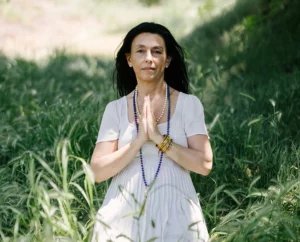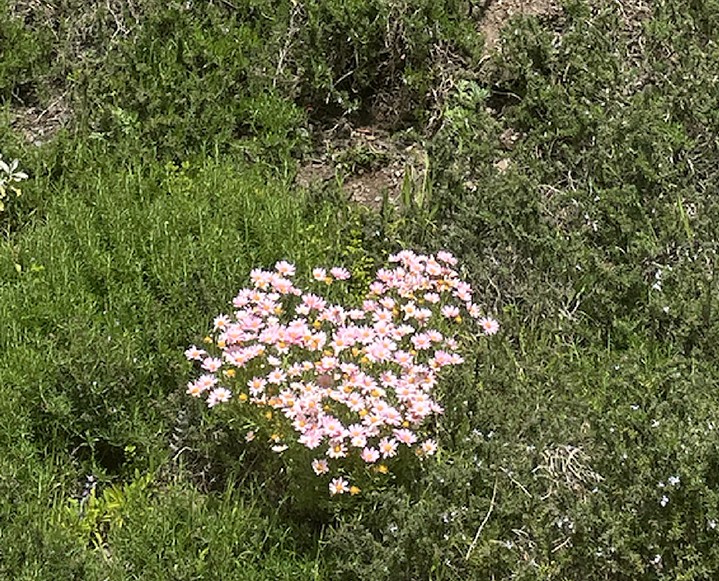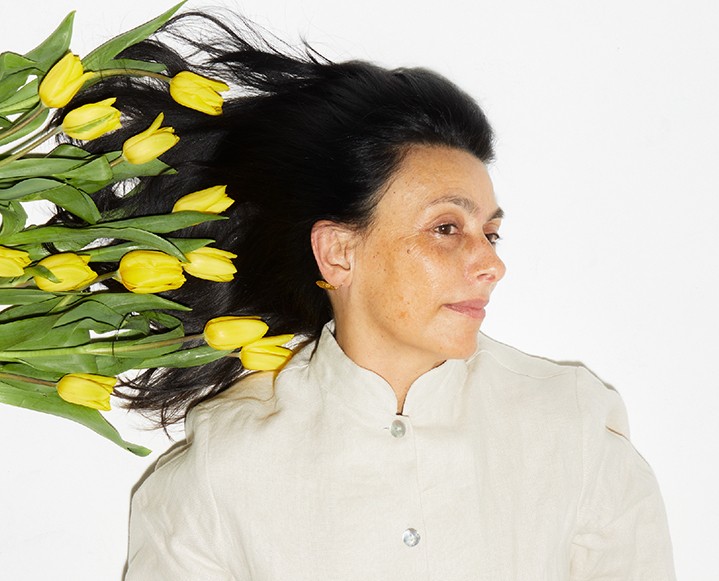
SPRING IS A BEAUTIFUL time for renewal, rebirth, and rejuvenation. However, spring is also a strange time of transition, where we find ourselves thawing from winter's introversion and becoming eager to grow our proverbial planted seeds as quickly as possible.
To help us avoid feeling the agitation that comes from seasonal shifts, we turned to the ancient wisdom of Ayurveda with the help of Martha Soffer, the healing mind and hands behind LA's most cherished Ayurvedia spa, Surya. Whether we're talking about Surya's stunning space in Santa Monica, their life-changing Panchakarma (you'll read about this more below), or their divinely feminine yoni steam, one thing remains true: there is something to be said for Ayurveda (and its been said for thousands of years).
Martha gave us tips on how to better align ourselves to our environment during this seasonal change. You might even want to take our Dosha Quiz first...
Transition Into Spring The Ayurvedic Way With Surya Spa's Martha Soffer
What is the ancient, spiritual significance of spring in Ayurveda?
Spring represents rebirth and renewal, new beginnings of seeds we’ve been sowing, and more sunshine and warmth. While most people think that the new year (in January!) is the best time to cleanse and reset, Ayurveda recommends cleansing in the spring. It’s the perfect time for some time spent at Surya!
What are the doshas of spring?
Spring is most dominated by the kapha dosha, made up of earth and water! Both kapha and spring share the characteristics of moistness, heaviness, congestion, and slowness. Think of a muddy pond, seeds sprouting in fertile, wet soil. Spring is sticky, slow, and ultra-fertile!
What are some emotions that come up for people as we transition from winter to spring?
Spring is often a time of profound emotional renewal. We’re coming out of the darkness of winter, often with the desire to renew and reset. It is common for people to feel the urge to make changes, both inside and out! While sometimes that can take the shape of spring cleaning at home, for others, it can look like a mind/body/spirit Panchakarma cleanse!
Based on the different doshas, what are foods people should be eating to help their bodies adapt better?
Ayurveda recommends eating kapha-pacifying food during the spring. Kapha-pacifying foods are light, spiced, and always easy to digest! Think: peppers, berries, spinach, lemon, lime, ginger, turmeric, cinnamon!

How does springtime affect each dosha differently?
Kapha is definitely most aggravated in the spring, therefore, people whose constitutions are led by kapha should be extra in touch with practices to stay balanced! Vata and pitta, on the other hand, stay pretty steady during the spring.
What are some rituals to consider to help this transition? Does it vary by dosha?
Consider what seeds you want to plant (literally and figuratively)…intention-setting, cleansing. Get in touch with nature! I intend to have a little ceremony in which I throw a collection of seeds around my garden. Last year I did this and a few months later there was a little heart patch of flowers growing in my garden — so magical! Spring is a time of profound happiness, sweetness, color, and new life. Really lean into this wonderful time.

why is spring such a great time to cleanse?
Spring is a wonderful time to cleanse, as it’s the season of rebirth. If you can’t do a full 3/5/7-Day Panchakarma with us at Surya, try our 5-day At-Home Cleanse. If you are near Surya in Santa Monica, pair that with a single Nourish / Restore Abhyanga + Shirodhara Treatment — and you’ll have a profound experience. In any case, the basic idea of a home cleanse (which is the same cleanse that people do before Panchakarma) is to gently loosen toxins, and then flush them from the system. It takes five days, and you will absolutely feel better.
If you’re a kapha-dominant person and feeling like the spring is really effecting you, try our Radiant Energy / Udvartana Scrub. It begins with our signature abhyanga and ends with a truly invigorating Ayurvedic scrub.
What is a Panchakarma, and how can people do it at home? Why is it helpful during seasonal shifts?
Panchakarma is an extended series of customized Ayurvedic treatments lasting 4 hours a day with two therapists that work in perfect synchrony, using oils that have been brewed and cooked especially for you. Panchakarma deeply cleanses the system and brings us back into a state of balance. Most Panchakarma treatments are complex and personalized, so I’d recommend coming into Surya for a cleanse of that depth.
On the other hand, our 5-day At-Home Cleanse, is very simple (but still very profound!), and can easily be done at home. For more things you can do at home, I always recommend the Ayurvedic staples, done seasonally, yes, when our bodies are adjusting to the new environment, but also as daily practices, because one way or the other, either externally or internally, our environment is always changing. I recommend dry brushing, self-abhyanga (with calming, cooling, or energizing oils), tongue scraping, oil pulling, yoga asanas, and especially meditation—something simple and effective like Transcendental Meditation, which only takes about 20 minutes a day, twice a day, and can change your inner environment very easily, harmonize it, and bring inside and out.
What are some herbs people should look to and why?
Durning spring, I recommend Kapha-pacifying herbs and spices like ginger, cinnamon, turmeric, black pepper, and dandelion. My favorite spring flower is the pansy. I love making a floral tea with it and having an early morning spring tea ceremony.

What are some activities to avoid or ramp up?
In spring, we want to lean into activities that are going to energize sluggish kapha—that heavier earth water dosha in our constitution. That could include a brisk morning walk, gentle movement in your garden, ocean swims, and at-home scrubs (I love mixing our energizing Abhyanga Oil with a pinch of our Black Lava Salt and giving myself a gentle full body scrub before my morning shower). It’s also a great time to be in nature and witness the rebirth of the world, and of course, do yoga, meditate, and feel where you are and how you are.
What are some eating rituals people should incorporate during mealtime?
During the spring, I start to lighten my meals, as well as integrate kapha-pacifying herbs and spices. I always pray before I eat, thanking the sun and the stars and the soil for all that they do to keep our planet alive, and to keep me and all of us alive. I also love drinking warm tea with my meals (my personal favorite is cumin coriander and fennel — so great for digestion)!
What is your specific morning ritual during the spring? Can you give us a Martha Day-in-the-Life?
I like to wake up early, do some asanas, meditate for 20 minutes, dry brush, and do a self-abhyanga, either extended if I can, or a quick one if I’m on the move. I drink some tea, and sometimes finish up the previous night’s batch of oil or creams, and head to Surya!
How do women’s bodies specifically shift per season?
Women’s bodies are particular sensitive to the seasonal shifts. Our menstrual cycles are linked to the moon, yes, but the change in seasons brings a many different hormonal and energetic shifts to our bodies. The start of spring marks a moment in which our channels open and we automatically begin to release accumulated toxins. This is why it’s such a great time for Panchakarma—nothing supports the process of releasing toxins more than that, and takes us deeper into the process of nourishment and rebirth.

Spring is confusing. In the winter, we need more nourishing, nutrient-dense foods, and in the summer, cooling foods. What should people consider in the spring?
Follow the weather and check in with your body. Kapha-pacifying foods are a great staple in the Spring. But on colder early days, integrate warm, grounding, nourishing Vata-pacifying foods (potatoes, beets, carrots, etc.) into your diet. As things start to warm up in late spring, start integrating more cooling foods (cucumber, watermelon, cilantro, etc.) into your diet! That’s the beauty of Ayurveda—do we need to calm down, cool down, or energize? We can feel that, and respond to it with activities and diet. We can trust the ways in which our body responds to the changes in the environment.
Can you share an ideal spring recipe for a seasonal staple dish?
For the cooler early spring days, I recommend a warm bowl of kitchari or dhal made with an energizing churna spice blend (and you can spruce it up with some seasonal edible flowers on top). So beautiful and tasty. Kitchari and dhal are a great way to stabilize the system during the season’s transition. Pair that meal with a warm cup of ginger tea, or a Whole Body Energy Ayurvedic Latte, with a little cinnamon, and you’ve got a meal that’s delicious, nourishing, and, well, actually medicinal. But you don’t have to tell anyone that!
For the warmer late spring days, I love balancing with cooling coconut cream and yogurt. It’s a sweet and cooling treat for a warm spring day.
What should people be on the lookout for as things shift into spring?
Watch for a surge in your kapha, which shows up as aggravation, and balance it with energizing foods, herbs, and activities. It’s really simple—if you’re feeling heavy, slow, tired, or foggy, it’s likely the change of the season effecting you, and that’s perfectly normal. Just ask yourself , "Do I need to calm down, cool down, or energize?"
In the end, Ayurveda is simple, and it’s a call to be in touch with your body, your feelings, and adjust. And we’ll always help you at Surya!
The post Transition Into Spring The Ayurvedic Way With Surya Spa’s Martha Soffer appeared first on The Chalkboard.
from The Chalkboard https://ift.tt/1jbTpA8
via IFTTT
No comments:
Post a Comment